Examining International and Non-International Armed Conflict Laws
VerifiedAdded on 2023/06/09
|27
|9200
|424
Essay
AI Summary
This essay provides a comprehensive analysis of the legal similarities and differences between international and non-international armed conflicts, particularly in the context of international humanitarian law. It discusses the historical development of the laws governing these conflicts, highlighting the evolution from primarily inter-state concerns to the regulation of internal conflicts. The essay examines the applicability of treaties like the Geneva Conventions and Additional Protocols, as well as customary international law, to both types of conflicts. It also addresses the reasons for the persistent distinction between the two, rooted in state sovereignty and security concerns. The analysis references key legal precedents, such as the Tadic case, and scholarly studies, including the ICRC study on customary international humanitarian law, to illustrate the complexities and ongoing debates surrounding the legal classification and regulation of armed conflicts. This assignment is available on Desklib, a platform offering a wide array of study tools and resources for students.
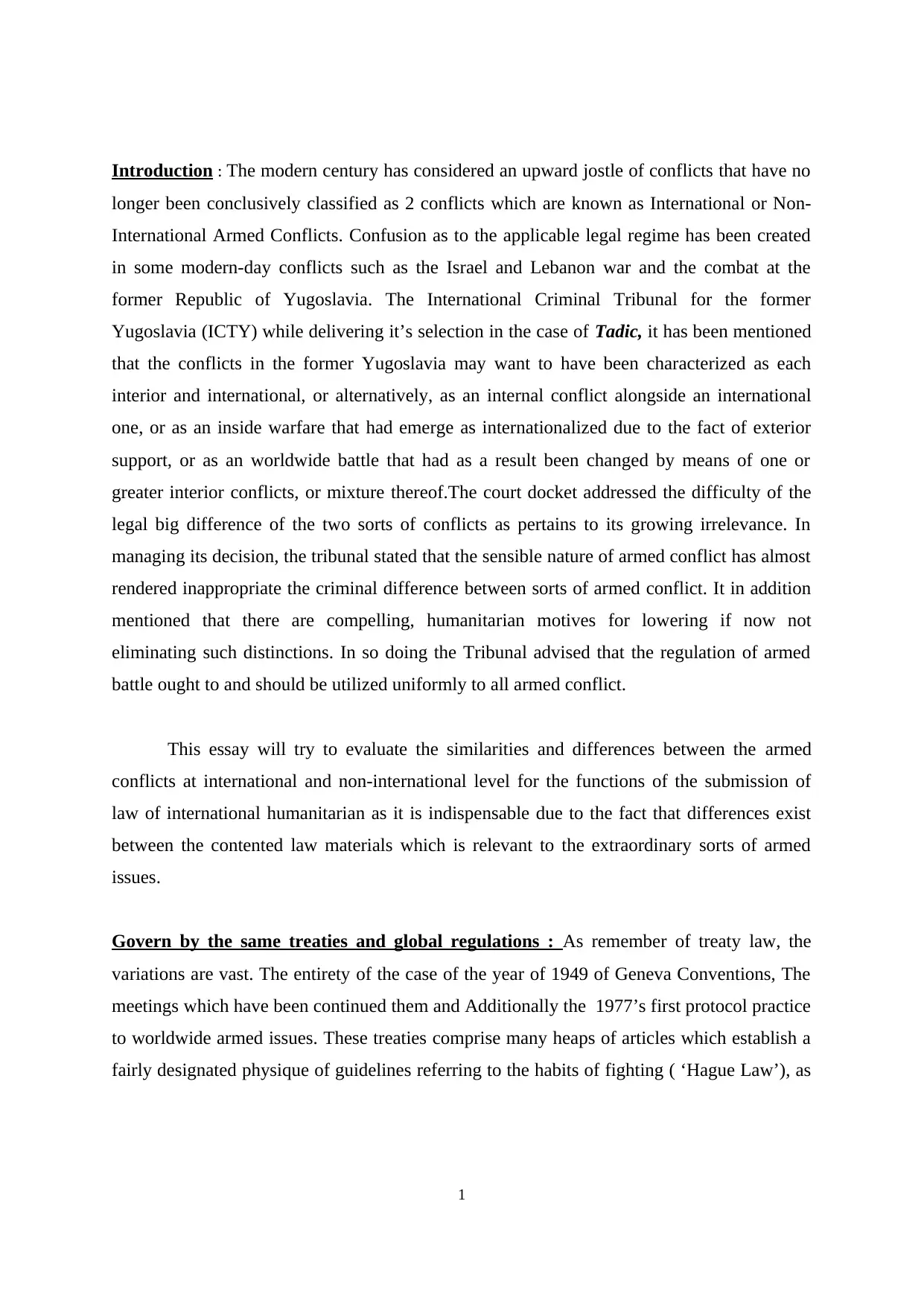
Introduction : The modern century has considered an upward jostle of conflicts that have no
longer been conclusively classified as 2 conflicts which are known as International or Non-
International Armed Conflicts. Confusion as to the applicable legal regime has been created
in some modern-day conflicts such as the Israel and Lebanon war and the combat at the
former Republic of Yugoslavia. The International Criminal Tribunal for the former
Yugoslavia (ICTY) while delivering it’s selection in the case of Tadic, it has been mentioned
that the conflicts in the former Yugoslavia may want to have been characterized as each
interior and international, or alternatively, as an internal conflict alongside an international
one, or as an inside warfare that had emerge as internationalized due to the fact of exterior
support, or as an worldwide battle that had as a result been changed by means of one or
greater interior conflicts, or mixture thereof.The court docket addressed the difficulty of the
legal big difference of the two sorts of conflicts as pertains to its growing irrelevance. In
managing its decision, the tribunal stated that the sensible nature of armed conflict has almost
rendered inappropriate the criminal difference between sorts of armed conflict. It in addition
mentioned that there are compelling, humanitarian motives for lowering if now not
eliminating such distinctions. In so doing the Tribunal advised that the regulation of armed
battle ought to and should be utilized uniformly to all armed conflict.
This essay will try to evaluate the similarities and differences between the armed
conflicts at international and non-international level for the functions of the submission of
law of international humanitarian as it is indispensable due to the fact that differences exist
between the contented law materials which is relevant to the extraordinary sorts of armed
issues.
Govern by the same treaties and global regulations : As remember of treaty law, the
variations are vast. The entirety of the case of the year of 1949 of Geneva Conventions, The
meetings which have been continued them and Additionally the 1977’s first protocol practice
to worldwide armed issues. These treaties comprise many heaps of articles which establish a
fairly designated physique of guidelines referring to the habits of fighting ( ‘Hague Law’), as
1
longer been conclusively classified as 2 conflicts which are known as International or Non-
International Armed Conflicts. Confusion as to the applicable legal regime has been created
in some modern-day conflicts such as the Israel and Lebanon war and the combat at the
former Republic of Yugoslavia. The International Criminal Tribunal for the former
Yugoslavia (ICTY) while delivering it’s selection in the case of Tadic, it has been mentioned
that the conflicts in the former Yugoslavia may want to have been characterized as each
interior and international, or alternatively, as an internal conflict alongside an international
one, or as an inside warfare that had emerge as internationalized due to the fact of exterior
support, or as an worldwide battle that had as a result been changed by means of one or
greater interior conflicts, or mixture thereof.The court docket addressed the difficulty of the
legal big difference of the two sorts of conflicts as pertains to its growing irrelevance. In
managing its decision, the tribunal stated that the sensible nature of armed conflict has almost
rendered inappropriate the criminal difference between sorts of armed conflict. It in addition
mentioned that there are compelling, humanitarian motives for lowering if now not
eliminating such distinctions. In so doing the Tribunal advised that the regulation of armed
battle ought to and should be utilized uniformly to all armed conflict.
This essay will try to evaluate the similarities and differences between the armed
conflicts at international and non-international level for the functions of the submission of
law of international humanitarian as it is indispensable due to the fact that differences exist
between the contented law materials which is relevant to the extraordinary sorts of armed
issues.
Govern by the same treaties and global regulations : As remember of treaty law, the
variations are vast. The entirety of the case of the year of 1949 of Geneva Conventions, The
meetings which have been continued them and Additionally the 1977’s first protocol practice
to worldwide armed issues. These treaties comprise many heaps of articles which establish a
fairly designated physique of guidelines referring to the habits of fighting ( ‘Hague Law’), as
1
Paraphrase This Document
Need a fresh take? Get an instant paraphrase of this document with our AI Paraphraser
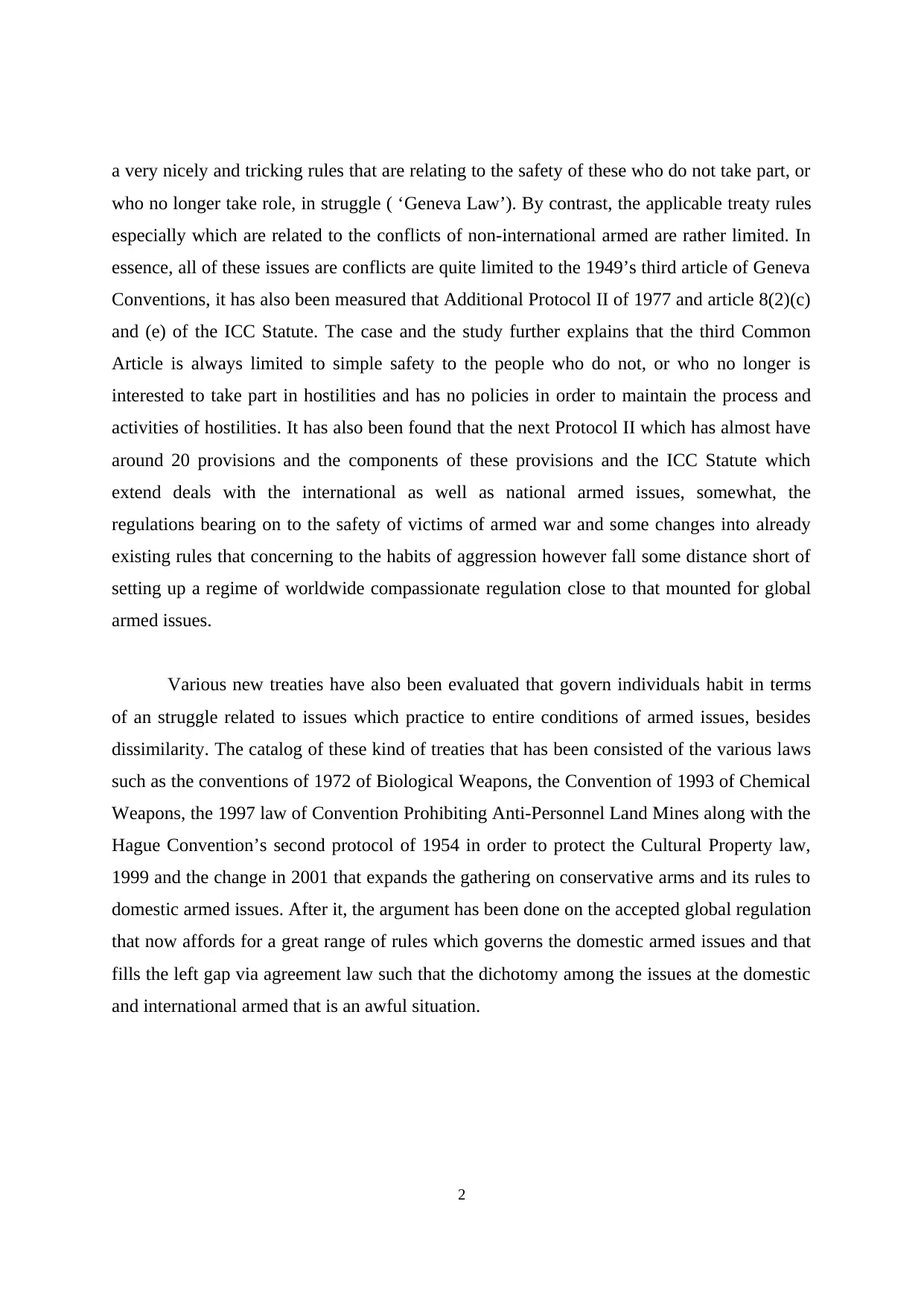
a very nicely and tricking rules that are relating to the safety of these who do not take part, or
who no longer take role, in struggle ( ‘Geneva Law’). By contrast, the applicable treaty rules
especially which are related to the conflicts of non-international armed are rather limited. In
essence, all of these issues are conflicts are quite limited to the 1949’s third article of Geneva
Conventions, it has also been measured that Additional Protocol II of 1977 and article 8(2)(c)
and (e) of the ICC Statute. The case and the study further explains that the third Common
Article is always limited to simple safety to the people who do not, or who no longer is
interested to take part in hostilities and has no policies in order to maintain the process and
activities of hostilities. It has also been found that the next Protocol II which has almost have
around 20 provisions and the components of these provisions and the ICC Statute which
extend deals with the international as well as national armed issues, somewhat, the
regulations bearing on to the safety of victims of armed war and some changes into already
existing rules that concerning to the habits of aggression however fall some distance short of
setting up a regime of worldwide compassionate regulation close to that mounted for global
armed issues.
Various new treaties have also been evaluated that govern individuals habit in terms
of an struggle related to issues which practice to entire conditions of armed issues, besides
dissimilarity. The catalog of these kind of treaties that has been consisted of the various laws
such as the conventions of 1972 of Biological Weapons, the Convention of 1993 of Chemical
Weapons, the 1997 law of Convention Prohibiting Anti-Personnel Land Mines along with the
Hague Convention’s second protocol of 1954 in order to protect the Cultural Property law,
1999 and the change in 2001 that expands the gathering on conservative arms and its rules to
domestic armed issues. After it, the argument has been done on the accepted global regulation
that now affords for a great range of rules which governs the domestic armed issues and that
fills the left gap via agreement law such that the dichotomy among the issues at the domestic
and international armed that is an awful situation.
2
who no longer take role, in struggle ( ‘Geneva Law’). By contrast, the applicable treaty rules
especially which are related to the conflicts of non-international armed are rather limited. In
essence, all of these issues are conflicts are quite limited to the 1949’s third article of Geneva
Conventions, it has also been measured that Additional Protocol II of 1977 and article 8(2)(c)
and (e) of the ICC Statute. The case and the study further explains that the third Common
Article is always limited to simple safety to the people who do not, or who no longer is
interested to take part in hostilities and has no policies in order to maintain the process and
activities of hostilities. It has also been found that the next Protocol II which has almost have
around 20 provisions and the components of these provisions and the ICC Statute which
extend deals with the international as well as national armed issues, somewhat, the
regulations bearing on to the safety of victims of armed war and some changes into already
existing rules that concerning to the habits of aggression however fall some distance short of
setting up a regime of worldwide compassionate regulation close to that mounted for global
armed issues.
Various new treaties have also been evaluated that govern individuals habit in terms
of an struggle related to issues which practice to entire conditions of armed issues, besides
dissimilarity. The catalog of these kind of treaties that has been consisted of the various laws
such as the conventions of 1972 of Biological Weapons, the Convention of 1993 of Chemical
Weapons, the 1997 law of Convention Prohibiting Anti-Personnel Land Mines along with the
Hague Convention’s second protocol of 1954 in order to protect the Cultural Property law,
1999 and the change in 2001 that expands the gathering on conservative arms and its rules to
domestic armed issues. After it, the argument has been done on the accepted global regulation
that now affords for a great range of rules which governs the domestic armed issues and that
fills the left gap via agreement law such that the dichotomy among the issues at the domestic
and international armed that is an awful situation.
2
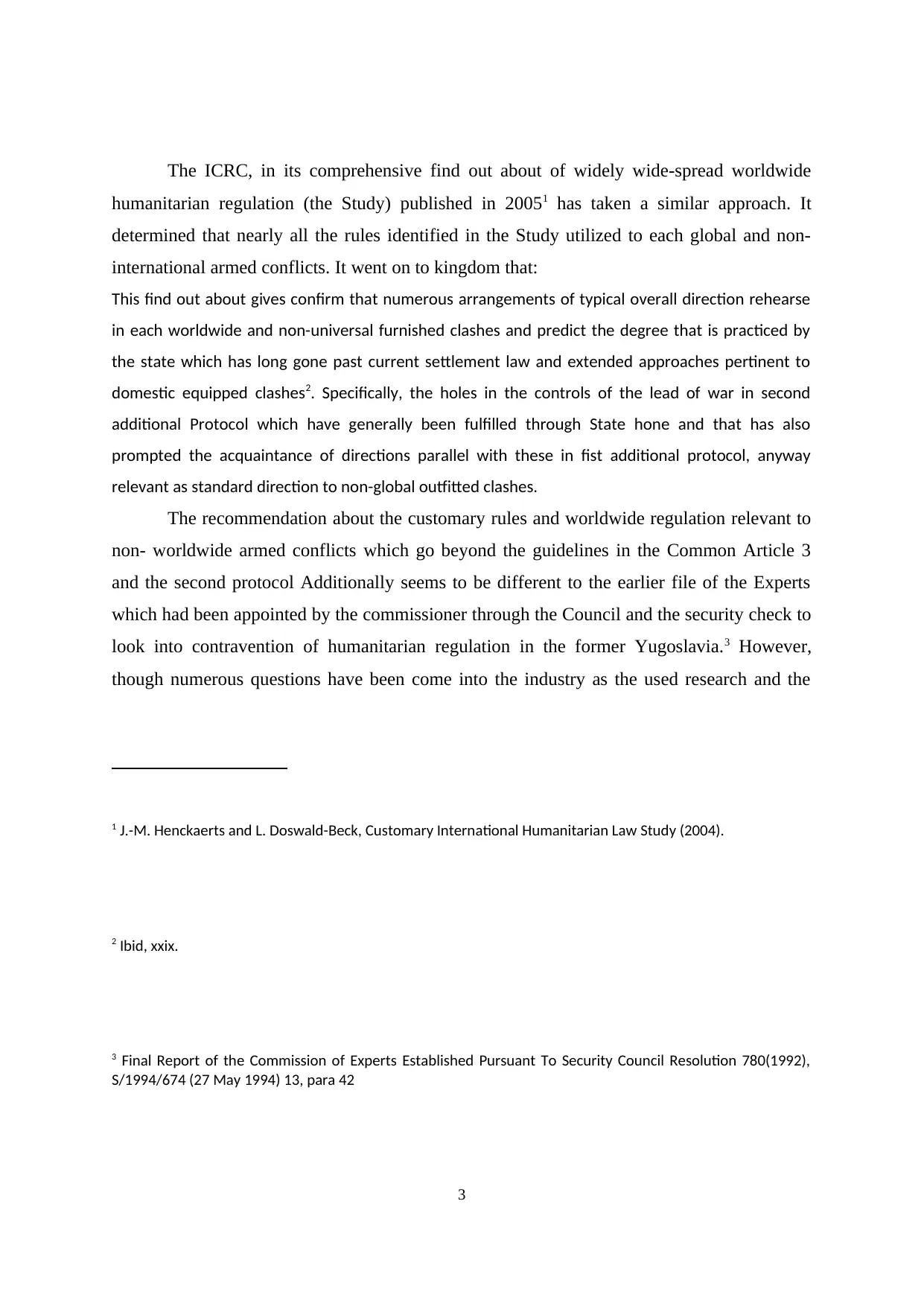
The ICRC, in its comprehensive find out about of widely wide-spread worldwide
humanitarian regulation (the Study) published in 20051 has taken a similar approach. It
determined that nearly all the rules identified in the Study utilized to each global and non-
international armed conflicts. It went on to kingdom that:
This find out about gives confirm that numerous arrangements of typical overall direction rehearse
in each worldwide and non-universal furnished clashes and predict the degree that is practiced by
the state which has long gone past current settlement law and extended approaches pertinent to
domestic equipped clashes2. Specifically, the holes in the controls of the lead of war in second
additional Protocol which have generally been fulfilled through State hone and that has also
prompted the acquaintance of directions parallel with these in fist additional protocol, anyway
relevant as standard direction to non-global outfitted clashes.
The recommendation about the customary rules and worldwide regulation relevant to
non- worldwide armed conflicts which go beyond the guidelines in the Common Article 3
and the second protocol Additionally seems to be different to the earlier file of the Experts
which had been appointed by the commissioner through the Council and the security check to
look into contravention of humanitarian regulation in the former Yugoslavia.3 However,
though numerous questions have been come into the industry as the used research and the
1 J.-M. Henckaerts and L. Doswald-Beck, Customary International Humanitarian Law Study (2004).
2 Ibid, xxix.
3 Final Report of the Commission of Experts Established Pursuant To Security Council Resolution 780(1992),
S/1994/674 (27 May 1994) 13, para 42
3
humanitarian regulation (the Study) published in 20051 has taken a similar approach. It
determined that nearly all the rules identified in the Study utilized to each global and non-
international armed conflicts. It went on to kingdom that:
This find out about gives confirm that numerous arrangements of typical overall direction rehearse
in each worldwide and non-universal furnished clashes and predict the degree that is practiced by
the state which has long gone past current settlement law and extended approaches pertinent to
domestic equipped clashes2. Specifically, the holes in the controls of the lead of war in second
additional Protocol which have generally been fulfilled through State hone and that has also
prompted the acquaintance of directions parallel with these in fist additional protocol, anyway
relevant as standard direction to non-global outfitted clashes.
The recommendation about the customary rules and worldwide regulation relevant to
non- worldwide armed conflicts which go beyond the guidelines in the Common Article 3
and the second protocol Additionally seems to be different to the earlier file of the Experts
which had been appointed by the commissioner through the Council and the security check to
look into contravention of humanitarian regulation in the former Yugoslavia.3 However,
though numerous questions have been come into the industry as the used research and the
1 J.-M. Henckaerts and L. Doswald-Beck, Customary International Humanitarian Law Study (2004).
2 Ibid, xxix.
3 Final Report of the Commission of Experts Established Pursuant To Security Council Resolution 780(1992),
S/1994/674 (27 May 1994) 13, para 42
3
⊘ This is a preview!⊘
Do you want full access?
Subscribe today to unlock all pages.

Trusted by 1+ million students worldwide
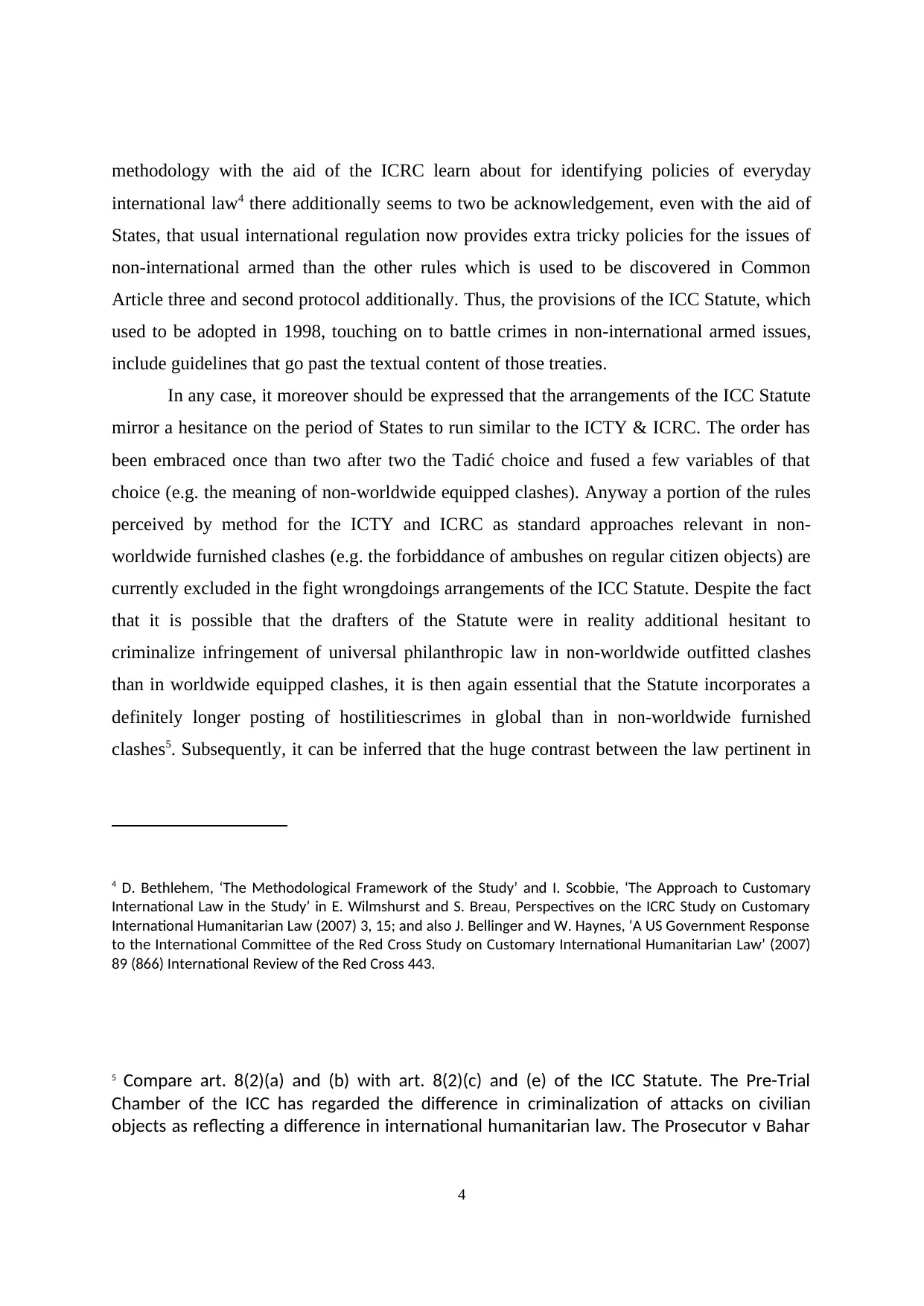
methodology with the aid of the ICRC learn about for identifying policies of everyday
international law4 there additionally seems to two be acknowledgement, even with the aid of
States, that usual international regulation now provides extra tricky policies for the issues of
non-international armed than the other rules which is used to be discovered in Common
Article three and second protocol additionally. Thus, the provisions of the ICC Statute, which
used to be adopted in 1998, touching on to battle crimes in non-international armed issues,
include guidelines that go past the textual content of those treaties.
In any case, it moreover should be expressed that the arrangements of the ICC Statute
mirror a hesitance on the period of States to run similar to the ICTY & ICRC. The order has
been embraced once than two after two the Tadić choice and fused a few variables of that
choice (e.g. the meaning of non-worldwide equipped clashes). Anyway a portion of the rules
perceived by method for the ICTY and ICRC as standard approaches relevant in non-
worldwide furnished clashes (e.g. the forbiddance of ambushes on regular citizen objects) are
currently excluded in the fight wrongdoings arrangements of the ICC Statute. Despite the fact
that it is possible that the drafters of the Statute were in reality additional hesitant to
criminalize infringement of universal philanthropic law in non-worldwide outfitted clashes
than in worldwide equipped clashes, it is then again essential that the Statute incorporates a
definitely longer posting of hostilitiescrimes in global than in non-worldwide furnished
clashes5. Subsequently, it can be inferred that the huge contrast between the law pertinent in
4 D. Bethlehem, ‘The Methodological Framework of the Study’ and I. Scobbie, ‘The Approach to Customary
International Law in the Study’ in E. Wilmshurst and S. Breau, Perspectives on the ICRC Study on Customary
International Humanitarian Law (2007) 3, 15; and also J. Bellinger and W. Haynes, ‘A US Government Response
to the International Committee of the Red Cross Study on Customary International Humanitarian Law’ (2007)
89 (866) International Review of the Red Cross 443.
5 Compare art. 8(2)(a) and (b) with art. 8(2)(c) and (e) of the ICC Statute. The Pre-Trial
Chamber of the ICC has regarded the difference in criminalization of attacks on civilian
objects as reflecting a difference in international humanitarian law. The Prosecutor v Bahar
4
international law4 there additionally seems to two be acknowledgement, even with the aid of
States, that usual international regulation now provides extra tricky policies for the issues of
non-international armed than the other rules which is used to be discovered in Common
Article three and second protocol additionally. Thus, the provisions of the ICC Statute, which
used to be adopted in 1998, touching on to battle crimes in non-international armed issues,
include guidelines that go past the textual content of those treaties.
In any case, it moreover should be expressed that the arrangements of the ICC Statute
mirror a hesitance on the period of States to run similar to the ICTY & ICRC. The order has
been embraced once than two after two the Tadić choice and fused a few variables of that
choice (e.g. the meaning of non-worldwide equipped clashes). Anyway a portion of the rules
perceived by method for the ICTY and ICRC as standard approaches relevant in non-
worldwide furnished clashes (e.g. the forbiddance of ambushes on regular citizen objects) are
currently excluded in the fight wrongdoings arrangements of the ICC Statute. Despite the fact
that it is possible that the drafters of the Statute were in reality additional hesitant to
criminalize infringement of universal philanthropic law in non-worldwide outfitted clashes
than in worldwide equipped clashes, it is then again essential that the Statute incorporates a
definitely longer posting of hostilitiescrimes in global than in non-worldwide furnished
clashes5. Subsequently, it can be inferred that the huge contrast between the law pertinent in
4 D. Bethlehem, ‘The Methodological Framework of the Study’ and I. Scobbie, ‘The Approach to Customary
International Law in the Study’ in E. Wilmshurst and S. Breau, Perspectives on the ICRC Study on Customary
International Humanitarian Law (2007) 3, 15; and also J. Bellinger and W. Haynes, ‘A US Government Response
to the International Committee of the Red Cross Study on Customary International Humanitarian Law’ (2007)
89 (866) International Review of the Red Cross 443.
5 Compare art. 8(2)(a) and (b) with art. 8(2)(c) and (e) of the ICC Statute. The Pre-Trial
Chamber of the ICC has regarded the difference in criminalization of attacks on civilian
objects as reflecting a difference in international humanitarian law. The Prosecutor v Bahar
4
Paraphrase This Document
Need a fresh take? Get an instant paraphrase of this document with our AI Paraphraser
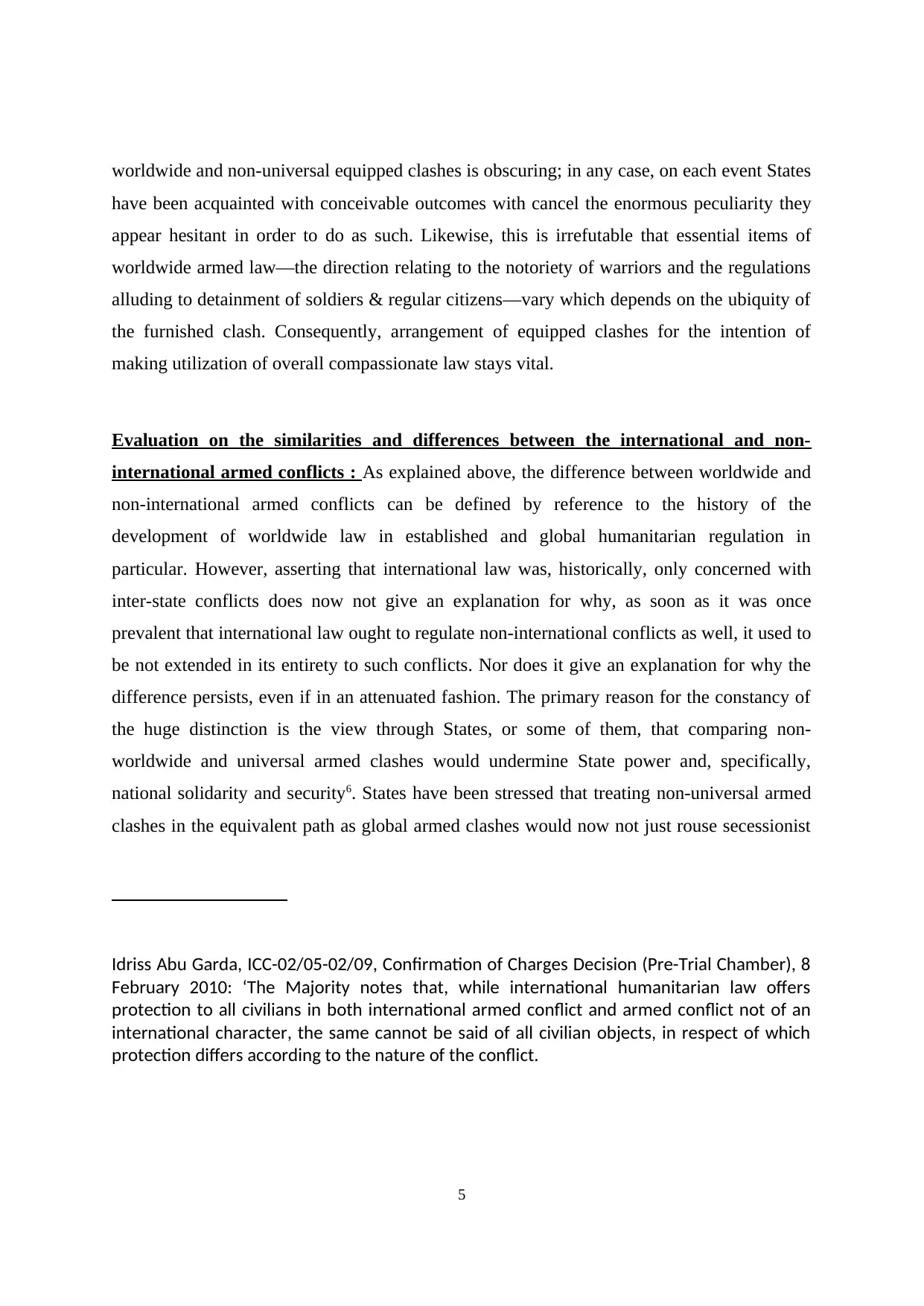
worldwide and non-universal equipped clashes is obscuring; in any case, on each event States
have been acquainted with conceivable outcomes with cancel the enormous peculiarity they
appear hesitant in order to do as such. Likewise, this is irrefutable that essential items of
worldwide armed law—the direction relating to the notoriety of warriors and the regulations
alluding to detainment of soldiers & regular citizens—vary which depends on the ubiquity of
the furnished clash. Consequently, arrangement of equipped clashes for the intention of
making utilization of overall compassionate law stays vital.
Evaluation on the similarities and differences between the international and non-
international armed conflicts : As explained above, the difference between worldwide and
non-international armed conflicts can be defined by reference to the history of the
development of worldwide law in established and global humanitarian regulation in
particular. However, asserting that international law was, historically, only concerned with
inter-state conflicts does now not give an explanation for why, as soon as it was once
prevalent that international law ought to regulate non-international conflicts as well, it used to
be not extended in its entirety to such conflicts. Nor does it give an explanation for why the
difference persists, even if in an attenuated fashion. The primary reason for the constancy of
the huge distinction is the view through States, or some of them, that comparing non-
worldwide and universal armed clashes would undermine State power and, specifically,
national solidarity and security6. States have been stressed that treating non-universal armed
clashes in the equivalent path as global armed clashes would now not just rouse secessionist
Idriss Abu Garda, ICC-02/05-02/09, Confirmation of Charges Decision (Pre-Trial Chamber), 8
February 2010: ‘The Majority notes that, while international humanitarian law offers
protection to all civilians in both international armed conflict and armed conflict not of an
international character, the same cannot be said of all civilian objects, in respect of which
protection differs according to the nature of the conflict.
5
have been acquainted with conceivable outcomes with cancel the enormous peculiarity they
appear hesitant in order to do as such. Likewise, this is irrefutable that essential items of
worldwide armed law—the direction relating to the notoriety of warriors and the regulations
alluding to detainment of soldiers & regular citizens—vary which depends on the ubiquity of
the furnished clash. Consequently, arrangement of equipped clashes for the intention of
making utilization of overall compassionate law stays vital.
Evaluation on the similarities and differences between the international and non-
international armed conflicts : As explained above, the difference between worldwide and
non-international armed conflicts can be defined by reference to the history of the
development of worldwide law in established and global humanitarian regulation in
particular. However, asserting that international law was, historically, only concerned with
inter-state conflicts does now not give an explanation for why, as soon as it was once
prevalent that international law ought to regulate non-international conflicts as well, it used to
be not extended in its entirety to such conflicts. Nor does it give an explanation for why the
difference persists, even if in an attenuated fashion. The primary reason for the constancy of
the huge distinction is the view through States, or some of them, that comparing non-
worldwide and universal armed clashes would undermine State power and, specifically,
national solidarity and security6. States have been stressed that treating non-universal armed
clashes in the equivalent path as global armed clashes would now not just rouse secessionist
Idriss Abu Garda, ICC-02/05-02/09, Confirmation of Charges Decision (Pre-Trial Chamber), 8
February 2010: ‘The Majority notes that, while international humanitarian law offers
protection to all civilians in both international armed conflict and armed conflict not of an
international character, the same cannot be said of all civilian objects, in respect of which
protection differs according to the nature of the conflict.
5
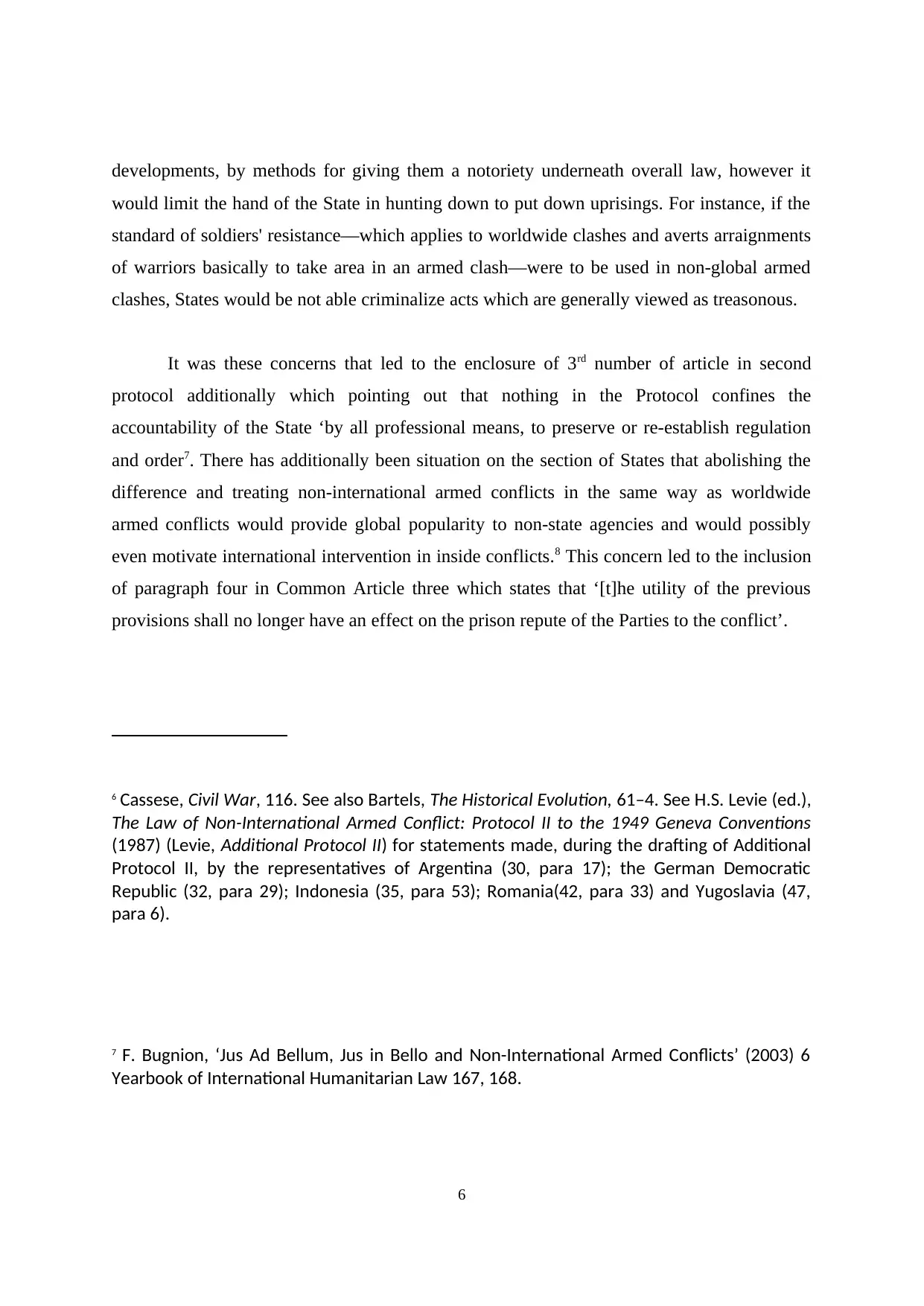
developments, by methods for giving them a notoriety underneath overall law, however it
would limit the hand of the State in hunting down to put down uprisings. For instance, if the
standard of soldiers' resistance—which applies to worldwide clashes and averts arraignments
of warriors basically to take area in an armed clash—were to be used in non-global armed
clashes, States would be not able criminalize acts which are generally viewed as treasonous.
It was these concerns that led to the enclosure of 3rd number of article in second
protocol additionally which pointing out that nothing in the Protocol confines the
accountability of the State ‘by all professional means, to preserve or re-establish regulation
and order7. There has additionally been situation on the section of States that abolishing the
difference and treating non-international armed conflicts in the same way as worldwide
armed conflicts would provide global popularity to non-state agencies and would possibly
even motivate international intervention in inside conflicts.8 This concern led to the inclusion
of paragraph four in Common Article three which states that ‘[t]he utility of the previous
provisions shall no longer have an effect on the prison repute of the Parties to the conflict’.
6 Cassese, Civil War, 116. See also Bartels, The Historical Evolution, 61–4. See H.S. Levie (ed.),
The Law of Non-International Armed Conflict: Protocol II to the 1949 Geneva Conventions
(1987) (Levie, Additional Protocol II) for statements made, during the drafting of Additional
Protocol II, by the representatives of Argentina (30, para 17); the German Democratic
Republic (32, para 29); Indonesia (35, para 53); Romania(42, para 33) and Yugoslavia (47,
para 6).
7 F. Bugnion, ‘Jus Ad Bellum, Jus in Bello and Non-International Armed Conflicts’ (2003) 6
Yearbook of International Humanitarian Law 167, 168.
6
would limit the hand of the State in hunting down to put down uprisings. For instance, if the
standard of soldiers' resistance—which applies to worldwide clashes and averts arraignments
of warriors basically to take area in an armed clash—were to be used in non-global armed
clashes, States would be not able criminalize acts which are generally viewed as treasonous.
It was these concerns that led to the enclosure of 3rd number of article in second
protocol additionally which pointing out that nothing in the Protocol confines the
accountability of the State ‘by all professional means, to preserve or re-establish regulation
and order7. There has additionally been situation on the section of States that abolishing the
difference and treating non-international armed conflicts in the same way as worldwide
armed conflicts would provide global popularity to non-state agencies and would possibly
even motivate international intervention in inside conflicts.8 This concern led to the inclusion
of paragraph four in Common Article three which states that ‘[t]he utility of the previous
provisions shall no longer have an effect on the prison repute of the Parties to the conflict’.
6 Cassese, Civil War, 116. See also Bartels, The Historical Evolution, 61–4. See H.S. Levie (ed.),
The Law of Non-International Armed Conflict: Protocol II to the 1949 Geneva Conventions
(1987) (Levie, Additional Protocol II) for statements made, during the drafting of Additional
Protocol II, by the representatives of Argentina (30, para 17); the German Democratic
Republic (32, para 29); Indonesia (35, para 53); Romania(42, para 33) and Yugoslavia (47,
para 6).
7 F. Bugnion, ‘Jus Ad Bellum, Jus in Bello and Non-International Armed Conflicts’ (2003) 6
Yearbook of International Humanitarian Law 167, 168.
6
⊘ This is a preview!⊘
Do you want full access?
Subscribe today to unlock all pages.

Trusted by 1+ million students worldwide
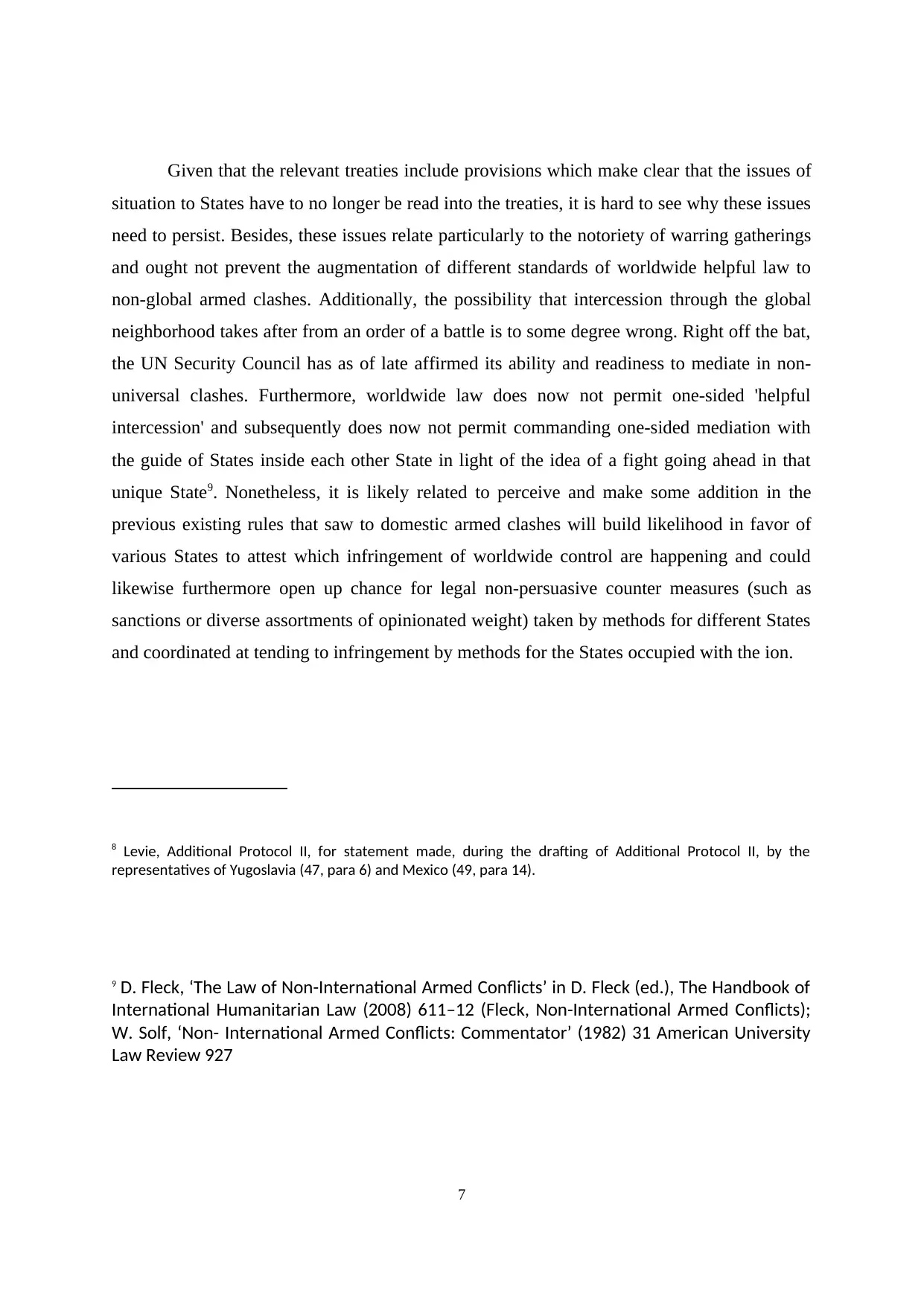
Given that the relevant treaties include provisions which make clear that the issues of
situation to States have to no longer be read into the treaties, it is hard to see why these issues
need to persist. Besides, these issues relate particularly to the notoriety of warring gatherings
and ought not prevent the augmentation of different standards of worldwide helpful law to
non-global armed clashes. Additionally, the possibility that intercession through the global
neighborhood takes after from an order of a battle is to some degree wrong. Right off the bat,
the UN Security Council has as of late affirmed its ability and readiness to mediate in non-
universal clashes. Furthermore, worldwide law does now not permit one-sided 'helpful
intercession' and subsequently does now not permit commanding one-sided mediation with
the guide of States inside each other State in light of the idea of a fight going ahead in that
unique State9. Nonetheless, it is likely related to perceive and make some addition in the
previous existing rules that saw to domestic armed clashes will build likelihood in favor of
various States to attest which infringement of worldwide control are happening and could
likewise furthermore open up chance for legal non-persuasive counter measures (such as
sanctions or diverse assortments of opinionated weight) taken by methods for different States
and coordinated at tending to infringement by methods for the States occupied with the ion.
8 Levie, Additional Protocol II, for statement made, during the drafting of Additional Protocol II, by the
representatives of Yugoslavia (47, para 6) and Mexico (49, para 14).
9 D. Fleck, ‘The Law of Non-International Armed Conflicts’ in D. Fleck (ed.), The Handbook of
International Humanitarian Law (2008) 611–12 (Fleck, Non-International Armed Conflicts);
W. Solf, ‘Non- International Armed Conflicts: Commentator’ (1982) 31 American University
Law Review 927
7
situation to States have to no longer be read into the treaties, it is hard to see why these issues
need to persist. Besides, these issues relate particularly to the notoriety of warring gatherings
and ought not prevent the augmentation of different standards of worldwide helpful law to
non-global armed clashes. Additionally, the possibility that intercession through the global
neighborhood takes after from an order of a battle is to some degree wrong. Right off the bat,
the UN Security Council has as of late affirmed its ability and readiness to mediate in non-
universal clashes. Furthermore, worldwide law does now not permit one-sided 'helpful
intercession' and subsequently does now not permit commanding one-sided mediation with
the guide of States inside each other State in light of the idea of a fight going ahead in that
unique State9. Nonetheless, it is likely related to perceive and make some addition in the
previous existing rules that saw to domestic armed clashes will build likelihood in favor of
various States to attest which infringement of worldwide control are happening and could
likewise furthermore open up chance for legal non-persuasive counter measures (such as
sanctions or diverse assortments of opinionated weight) taken by methods for different States
and coordinated at tending to infringement by methods for the States occupied with the ion.
8 Levie, Additional Protocol II, for statement made, during the drafting of Additional Protocol II, by the
representatives of Yugoslavia (47, para 6) and Mexico (49, para 14).
9 D. Fleck, ‘The Law of Non-International Armed Conflicts’ in D. Fleck (ed.), The Handbook of
International Humanitarian Law (2008) 611–12 (Fleck, Non-International Armed Conflicts);
W. Solf, ‘Non- International Armed Conflicts: Commentator’ (1982) 31 American University
Law Review 927
7
Paraphrase This Document
Need a fresh take? Get an instant paraphrase of this document with our AI Paraphraser
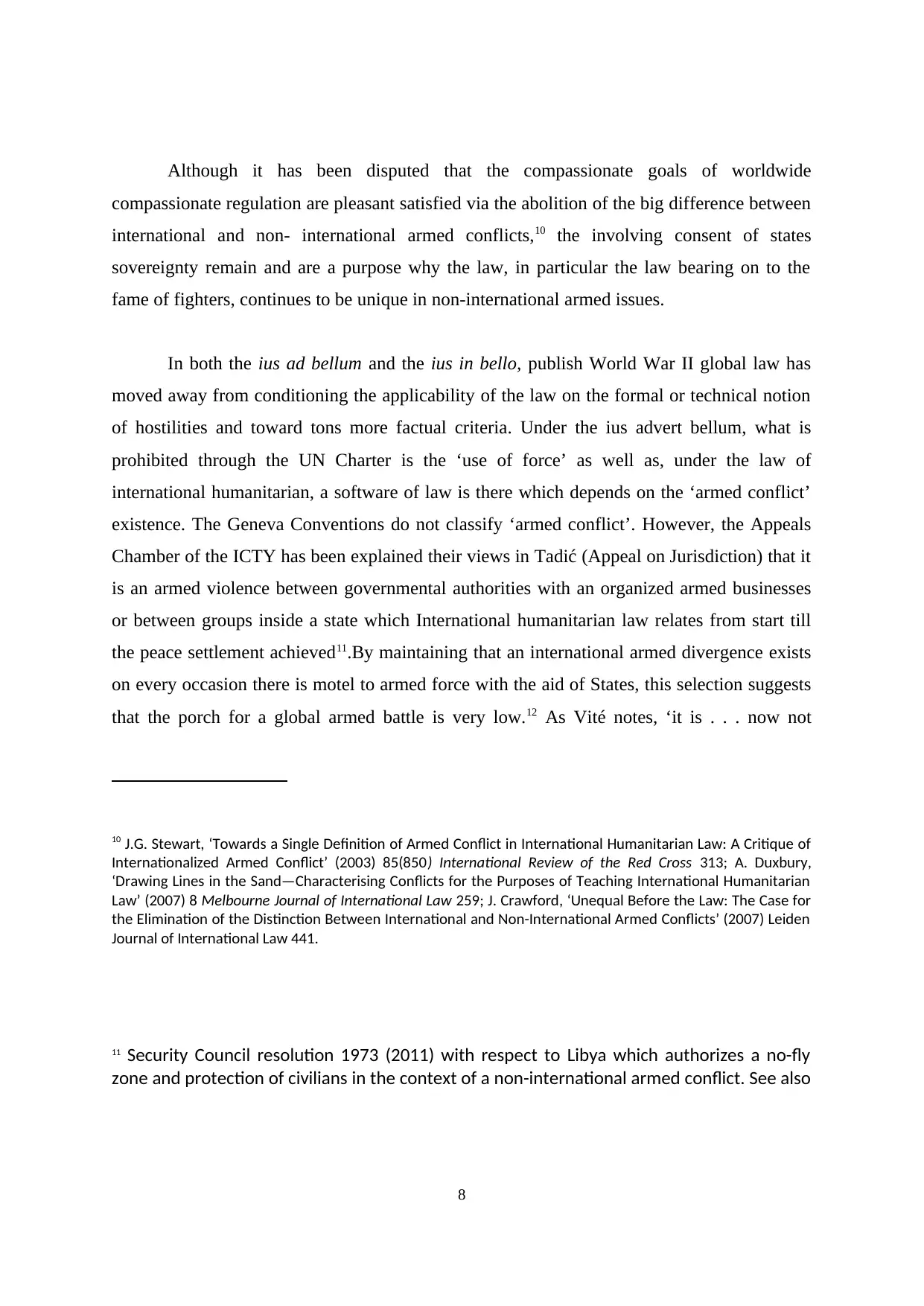
Although it has been disputed that the compassionate goals of worldwide
compassionate regulation are pleasant satisfied via the abolition of the big difference between
international and non- international armed conflicts,10 the involving consent of states
sovereignty remain and are a purpose why the law, in particular the law bearing on to the
fame of fighters, continues to be unique in non-international armed issues.
In both the ius ad bellum and the ius in bello, publish World War II global law has
moved away from conditioning the applicability of the law on the formal or technical notion
of hostilities and toward tons more factual criteria. Under the ius advert bellum, what is
prohibited through the UN Charter is the ‘use of force’ as well as, under the law of
international humanitarian, a software of law is there which depends on the ‘armed conflict’
existence. The Geneva Conventions do not classify ‘armed conflict’. However, the Appeals
Chamber of the ICTY has been explained their views in Tadić (Appeal on Jurisdiction) that it
is an armed violence between governmental authorities with an organized armed businesses
or between groups inside a state which International humanitarian law relates from start till
the peace settlement achieved11.By maintaining that an international armed divergence exists
on every occasion there is motel to armed force with the aid of States, this selection suggests
that the porch for a global armed battle is very low.12 As Vité notes, ‘it is . . . now not
10 J.G. Stewart, ‘Towards a Single Definition of Armed Conflict in International Humanitarian Law: A Critique of
Internationalized Armed Conflict’ (2003) 85(850) International Review of the Red Cross 313; A. Duxbury,
‘Drawing Lines in the Sand—Characterising Conflicts for the Purposes of Teaching International Humanitarian
Law’ (2007) 8 Melbourne Journal of International Law 259; J. Crawford, ‘Unequal Before the Law: The Case for
the Elimination of the Distinction Between International and Non-International Armed Conflicts’ (2007) Leiden
Journal of International Law 441.
11 Security Council resolution 1973 (2011) with respect to Libya which authorizes a no-fly
zone and protection of civilians in the context of a non-international armed conflict. See also
8
compassionate regulation are pleasant satisfied via the abolition of the big difference between
international and non- international armed conflicts,10 the involving consent of states
sovereignty remain and are a purpose why the law, in particular the law bearing on to the
fame of fighters, continues to be unique in non-international armed issues.
In both the ius ad bellum and the ius in bello, publish World War II global law has
moved away from conditioning the applicability of the law on the formal or technical notion
of hostilities and toward tons more factual criteria. Under the ius advert bellum, what is
prohibited through the UN Charter is the ‘use of force’ as well as, under the law of
international humanitarian, a software of law is there which depends on the ‘armed conflict’
existence. The Geneva Conventions do not classify ‘armed conflict’. However, the Appeals
Chamber of the ICTY has been explained their views in Tadić (Appeal on Jurisdiction) that it
is an armed violence between governmental authorities with an organized armed businesses
or between groups inside a state which International humanitarian law relates from start till
the peace settlement achieved11.By maintaining that an international armed divergence exists
on every occasion there is motel to armed force with the aid of States, this selection suggests
that the porch for a global armed battle is very low.12 As Vité notes, ‘it is . . . now not
10 J.G. Stewart, ‘Towards a Single Definition of Armed Conflict in International Humanitarian Law: A Critique of
Internationalized Armed Conflict’ (2003) 85(850) International Review of the Red Cross 313; A. Duxbury,
‘Drawing Lines in the Sand—Characterising Conflicts for the Purposes of Teaching International Humanitarian
Law’ (2007) 8 Melbourne Journal of International Law 259; J. Crawford, ‘Unequal Before the Law: The Case for
the Elimination of the Distinction Between International and Non-International Armed Conflicts’ (2007) Leiden
Journal of International Law 441.
11 Security Council resolution 1973 (2011) with respect to Libya which authorizes a no-fly
zone and protection of civilians in the context of a non-international armed conflict. See also
8
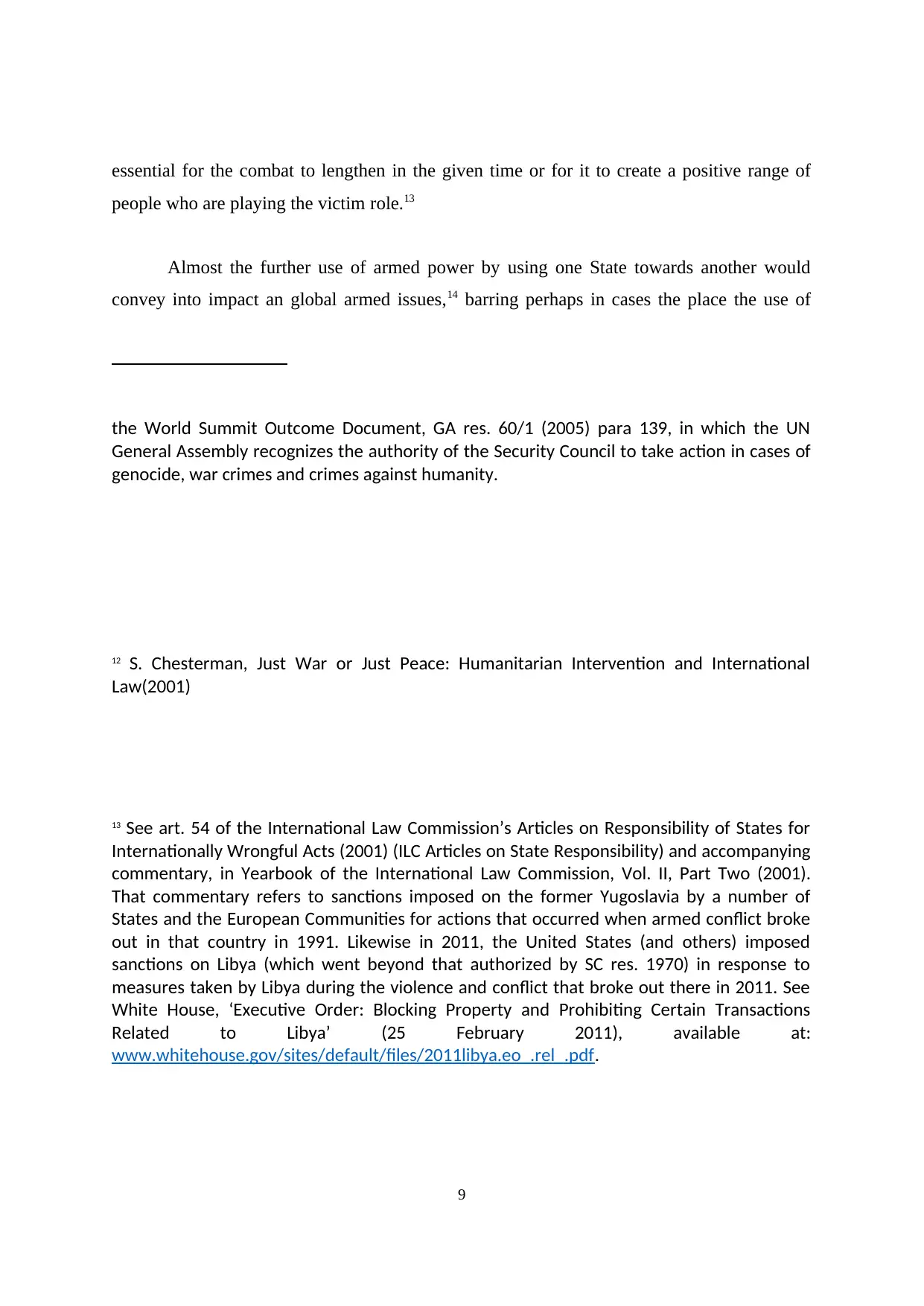
essential for the combat to lengthen in the given time or for it to create a positive range of
people who are playing the victim role.13
Almost the further use of armed power by using one State towards another would
convey into impact an global armed issues,14 barring perhaps in cases the place the use of
the World Summit Outcome Document, GA res. 60/1 (2005) para 139, in which the UN
General Assembly recognizes the authority of the Security Council to take action in cases of
genocide, war crimes and crimes against humanity.
12 S. Chesterman, Just War or Just Peace: Humanitarian Intervention and International
Law(2001)
13 See art. 54 of the International Law Commission’s Articles on Responsibility of States for
Internationally Wrongful Acts (2001) (ILC Articles on State Responsibility) and accompanying
commentary, in Yearbook of the International Law Commission, Vol. II, Part Two (2001).
That commentary refers to sanctions imposed on the former Yugoslavia by a number of
States and the European Communities for actions that occurred when armed conflict broke
out in that country in 1991. Likewise in 2011, the United States (and others) imposed
sanctions on Libya (which went beyond that authorized by SC res. 1970) in response to
measures taken by Libya during the violence and conflict that broke out there in 2011. See
White House, ‘Executive Order: Blocking Property and Prohibiting Certain Transactions
Related to Libya’ (25 February 2011), available at:
www.whitehouse.gov/sites/default/files/2011libya.eo_.rel_.pdf.
9
people who are playing the victim role.13
Almost the further use of armed power by using one State towards another would
convey into impact an global armed issues,14 barring perhaps in cases the place the use of
the World Summit Outcome Document, GA res. 60/1 (2005) para 139, in which the UN
General Assembly recognizes the authority of the Security Council to take action in cases of
genocide, war crimes and crimes against humanity.
12 S. Chesterman, Just War or Just Peace: Humanitarian Intervention and International
Law(2001)
13 See art. 54 of the International Law Commission’s Articles on Responsibility of States for
Internationally Wrongful Acts (2001) (ILC Articles on State Responsibility) and accompanying
commentary, in Yearbook of the International Law Commission, Vol. II, Part Two (2001).
That commentary refers to sanctions imposed on the former Yugoslavia by a number of
States and the European Communities for actions that occurred when armed conflict broke
out in that country in 1991. Likewise in 2011, the United States (and others) imposed
sanctions on Libya (which went beyond that authorized by SC res. 1970) in response to
measures taken by Libya during the violence and conflict that broke out there in 2011. See
White House, ‘Executive Order: Blocking Property and Prohibiting Certain Transactions
Related to Libya’ (25 February 2011), available at:
www.whitehouse.gov/sites/default/files/2011libya.eo_.rel_.pdf.
9
⊘ This is a preview!⊘
Do you want full access?
Subscribe today to unlock all pages.

Trusted by 1+ million students worldwide
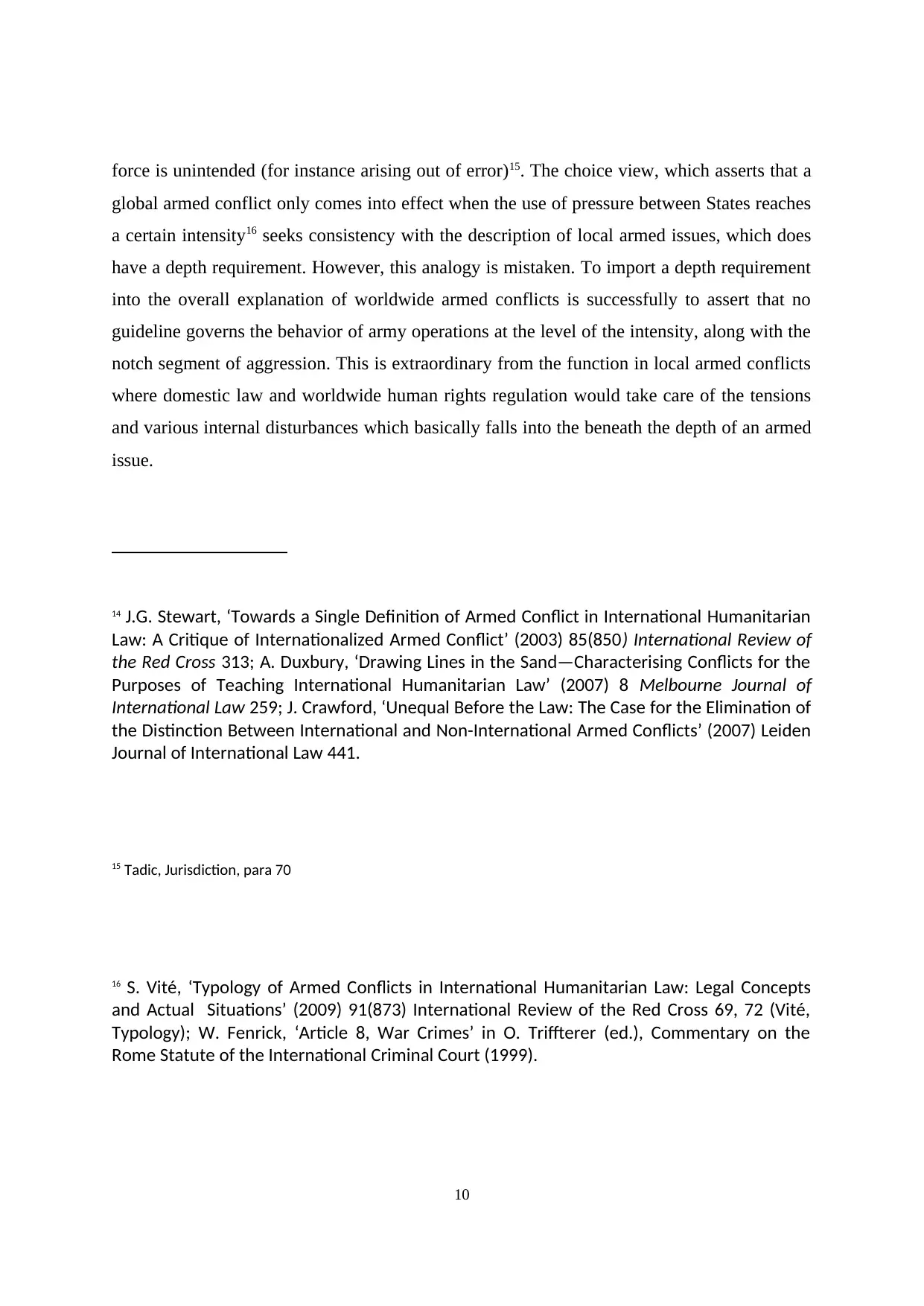
force is unintended (for instance arising out of error)15. The choice view, which asserts that a
global armed conflict only comes into effect when the use of pressure between States reaches
a certain intensity16 seeks consistency with the description of local armed issues, which does
have a depth requirement. However, this analogy is mistaken. To import a depth requirement
into the overall explanation of worldwide armed conflicts is successfully to assert that no
guideline governs the behavior of army operations at the level of the intensity, along with the
notch segment of aggression. This is extraordinary from the function in local armed conflicts
where domestic law and worldwide human rights regulation would take care of the tensions
and various internal disturbances which basically falls into the beneath the depth of an armed
issue.
14 J.G. Stewart, ‘Towards a Single Definition of Armed Conflict in International Humanitarian
Law: A Critique of Internationalized Armed Conflict’ (2003) 85(850) International Review of
the Red Cross 313; A. Duxbury, ‘Drawing Lines in the Sand—Characterising Conflicts for the
Purposes of Teaching International Humanitarian Law’ (2007) 8 Melbourne Journal of
International Law 259; J. Crawford, ‘Unequal Before the Law: The Case for the Elimination of
the Distinction Between International and Non-International Armed Conflicts’ (2007) Leiden
Journal of International Law 441.
15 Tadic, Jurisdiction, para 70
16 S. Vité, ‘Typology of Armed Conflicts in International Humanitarian Law: Legal Concepts
and Actual Situations’ (2009) 91(873) International Review of the Red Cross 69, 72 (Vité,
Typology); W. Fenrick, ‘Article 8, War Crimes’ in O. Triffterer (ed.), Commentary on the
Rome Statute of the International Criminal Court (1999).
10
global armed conflict only comes into effect when the use of pressure between States reaches
a certain intensity16 seeks consistency with the description of local armed issues, which does
have a depth requirement. However, this analogy is mistaken. To import a depth requirement
into the overall explanation of worldwide armed conflicts is successfully to assert that no
guideline governs the behavior of army operations at the level of the intensity, along with the
notch segment of aggression. This is extraordinary from the function in local armed conflicts
where domestic law and worldwide human rights regulation would take care of the tensions
and various internal disturbances which basically falls into the beneath the depth of an armed
issue.
14 J.G. Stewart, ‘Towards a Single Definition of Armed Conflict in International Humanitarian
Law: A Critique of Internationalized Armed Conflict’ (2003) 85(850) International Review of
the Red Cross 313; A. Duxbury, ‘Drawing Lines in the Sand—Characterising Conflicts for the
Purposes of Teaching International Humanitarian Law’ (2007) 8 Melbourne Journal of
International Law 259; J. Crawford, ‘Unequal Before the Law: The Case for the Elimination of
the Distinction Between International and Non-International Armed Conflicts’ (2007) Leiden
Journal of International Law 441.
15 Tadic, Jurisdiction, para 70
16 S. Vité, ‘Typology of Armed Conflicts in International Humanitarian Law: Legal Concepts
and Actual Situations’ (2009) 91(873) International Review of the Red Cross 69, 72 (Vité,
Typology); W. Fenrick, ‘Article 8, War Crimes’ in O. Triffterer (ed.), Commentary on the
Rome Statute of the International Criminal Court (1999).
10
Paraphrase This Document
Need a fresh take? Get an instant paraphrase of this document with our AI Paraphraser
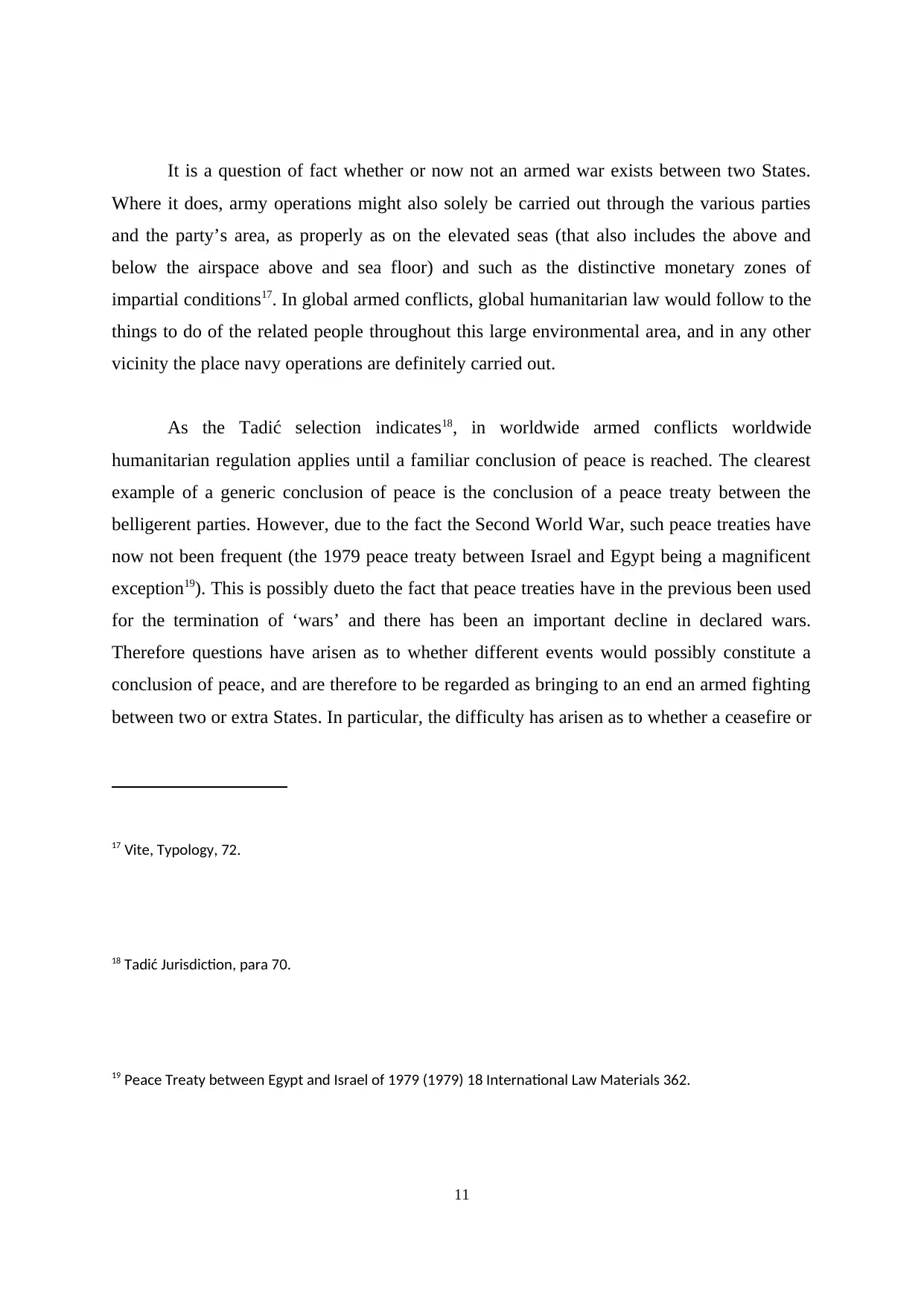
It is a question of fact whether or now not an armed war exists between two States.
Where it does, army operations might also solely be carried out through the various parties
and the party’s area, as properly as on the elevated seas (that also includes the above and
below the airspace above and sea floor) and such as the distinctive monetary zones of
impartial conditions17. In global armed conflicts, global humanitarian law would follow to the
things to do of the related people throughout this large environmental area, and in any other
vicinity the place navy operations are definitely carried out.
As the Tadić selection indicates18, in worldwide armed conflicts worldwide
humanitarian regulation applies until a familiar conclusion of peace is reached. The clearest
example of a generic conclusion of peace is the conclusion of a peace treaty between the
belligerent parties. However, due to the fact the Second World War, such peace treaties have
now not been frequent (the 1979 peace treaty between Israel and Egypt being a magnificent
exception19). This is possibly dueto the fact that peace treaties have in the previous been used
for the termination of ‘wars’ and there has been an important decline in declared wars.
Therefore questions have arisen as to whether different events would possibly constitute a
conclusion of peace, and are therefore to be regarded as bringing to an end an armed fighting
between two or extra States. In particular, the difficulty has arisen as to whether a ceasefire or
17 Vite, Typology, 72.
18 Tadić Jurisdiction, para 70.
19 Peace Treaty between Egypt and Israel of 1979 (1979) 18 International Law Materials 362.
11
Where it does, army operations might also solely be carried out through the various parties
and the party’s area, as properly as on the elevated seas (that also includes the above and
below the airspace above and sea floor) and such as the distinctive monetary zones of
impartial conditions17. In global armed conflicts, global humanitarian law would follow to the
things to do of the related people throughout this large environmental area, and in any other
vicinity the place navy operations are definitely carried out.
As the Tadić selection indicates18, in worldwide armed conflicts worldwide
humanitarian regulation applies until a familiar conclusion of peace is reached. The clearest
example of a generic conclusion of peace is the conclusion of a peace treaty between the
belligerent parties. However, due to the fact the Second World War, such peace treaties have
now not been frequent (the 1979 peace treaty between Israel and Egypt being a magnificent
exception19). This is possibly dueto the fact that peace treaties have in the previous been used
for the termination of ‘wars’ and there has been an important decline in declared wars.
Therefore questions have arisen as to whether different events would possibly constitute a
conclusion of peace, and are therefore to be regarded as bringing to an end an armed fighting
between two or extra States. In particular, the difficulty has arisen as to whether a ceasefire or
17 Vite, Typology, 72.
18 Tadić Jurisdiction, para 70.
19 Peace Treaty between Egypt and Israel of 1979 (1979) 18 International Law Materials 362.
11
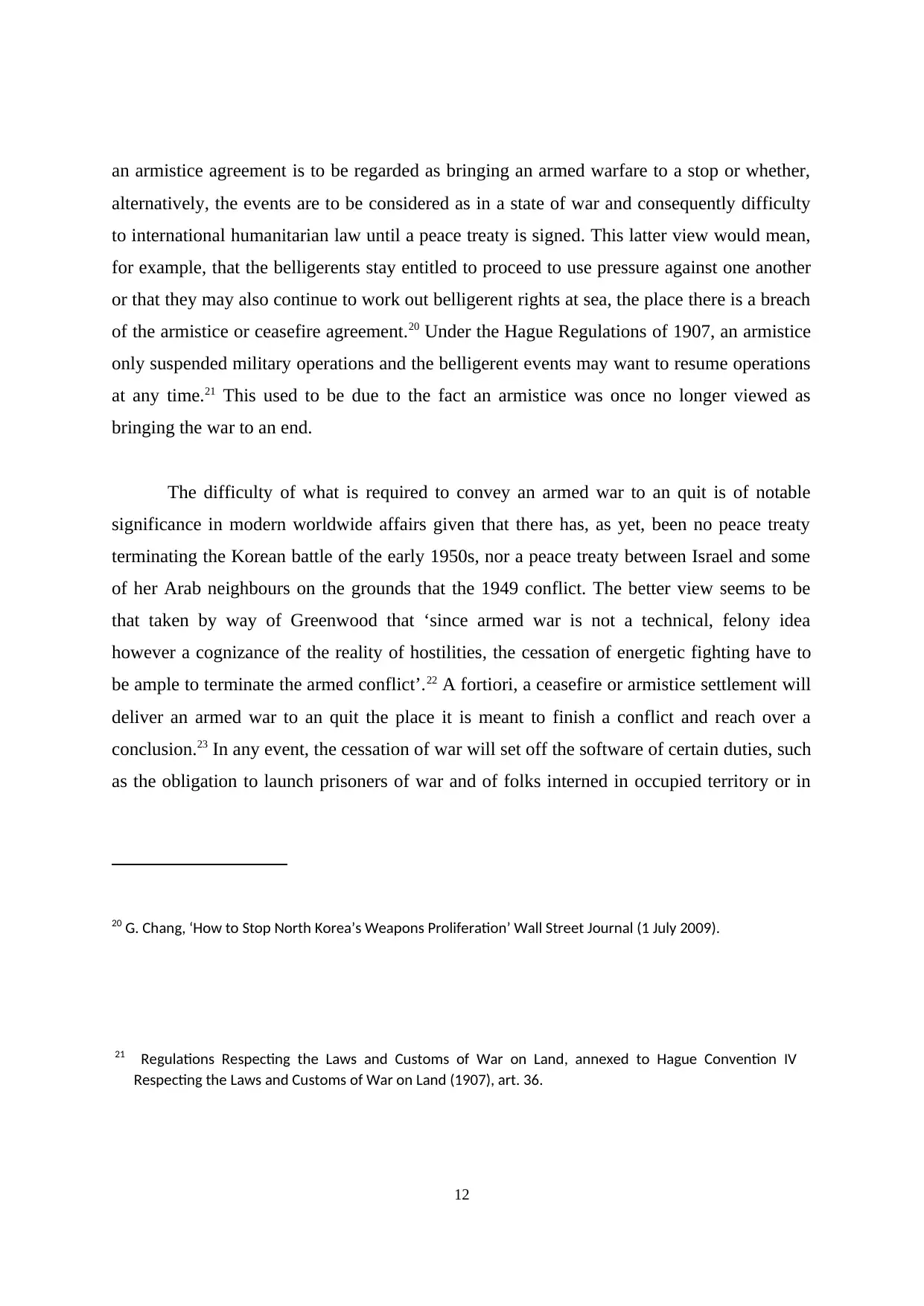
an armistice agreement is to be regarded as bringing an armed warfare to a stop or whether,
alternatively, the events are to be considered as in a state of war and consequently difficulty
to international humanitarian law until a peace treaty is signed. This latter view would mean,
for example, that the belligerents stay entitled to proceed to use pressure against one another
or that they may also continue to work out belligerent rights at sea, the place there is a breach
of the armistice or ceasefire agreement.20 Under the Hague Regulations of 1907, an armistice
only suspended military operations and the belligerent events may want to resume operations
at any time.21 This used to be due to the fact an armistice was once no longer viewed as
bringing the war to an end.
The difficulty of what is required to convey an armed war to an quit is of notable
significance in modern worldwide affairs given that there has, as yet, been no peace treaty
terminating the Korean battle of the early 1950s, nor a peace treaty between Israel and some
of her Arab neighbours on the grounds that the 1949 conflict. The better view seems to be
that taken by way of Greenwood that ‘since armed war is not a technical, felony idea
however a cognizance of the reality of hostilities, the cessation of energetic fighting have to
be ample to terminate the armed conflict’.22 A fortiori, a ceasefire or armistice settlement will
deliver an armed war to an quit the place it is meant to finish a conflict and reach over a
conclusion.23 In any event, the cessation of war will set off the software of certain duties, such
as the obligation to launch prisoners of war and of folks interned in occupied territory or in
20 G. Chang, ‘How to Stop North Korea’s Weapons Proliferation’ Wall Street Journal (1 July 2009).
21 Regulations Respecting the Laws and Customs of War on Land, annexed to Hague Convention IV
Respecting the Laws and Customs of War on Land (1907), art. 36.
12
alternatively, the events are to be considered as in a state of war and consequently difficulty
to international humanitarian law until a peace treaty is signed. This latter view would mean,
for example, that the belligerents stay entitled to proceed to use pressure against one another
or that they may also continue to work out belligerent rights at sea, the place there is a breach
of the armistice or ceasefire agreement.20 Under the Hague Regulations of 1907, an armistice
only suspended military operations and the belligerent events may want to resume operations
at any time.21 This used to be due to the fact an armistice was once no longer viewed as
bringing the war to an end.
The difficulty of what is required to convey an armed war to an quit is of notable
significance in modern worldwide affairs given that there has, as yet, been no peace treaty
terminating the Korean battle of the early 1950s, nor a peace treaty between Israel and some
of her Arab neighbours on the grounds that the 1949 conflict. The better view seems to be
that taken by way of Greenwood that ‘since armed war is not a technical, felony idea
however a cognizance of the reality of hostilities, the cessation of energetic fighting have to
be ample to terminate the armed conflict’.22 A fortiori, a ceasefire or armistice settlement will
deliver an armed war to an quit the place it is meant to finish a conflict and reach over a
conclusion.23 In any event, the cessation of war will set off the software of certain duties, such
as the obligation to launch prisoners of war and of folks interned in occupied territory or in
20 G. Chang, ‘How to Stop North Korea’s Weapons Proliferation’ Wall Street Journal (1 July 2009).
21 Regulations Respecting the Laws and Customs of War on Land, annexed to Hague Convention IV
Respecting the Laws and Customs of War on Land (1907), art. 36.
12
⊘ This is a preview!⊘
Do you want full access?
Subscribe today to unlock all pages.

Trusted by 1+ million students worldwide
1 out of 27
Related Documents
Your All-in-One AI-Powered Toolkit for Academic Success.
+13062052269
info@desklib.com
Available 24*7 on WhatsApp / Email
![[object Object]](/_next/static/media/star-bottom.7253800d.svg)
Unlock your academic potential
Copyright © 2020–2025 A2Z Services. All Rights Reserved. Developed and managed by ZUCOL.




